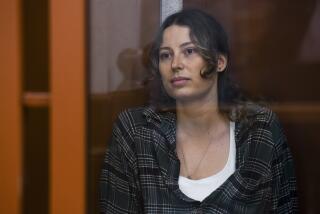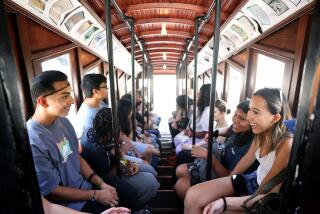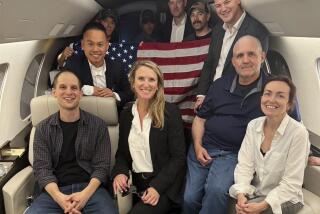15 Soviet Teen-Agers Wrap Up Visit With Pledges of Peace, Friendship
- Share via
It was only a game of musical chairs. But when the music stopped, the final two challengers for the single chair were a Soviet and an American--a situation Ronald Reagan and Mikhail Gorbachev might appreciate.
As it happened, the players Sunday morning in a recreation room of the Church of Religious Science in Huntington Beach were Martin Hennessey, 18, of Maui and Ruslan Bogoutainov, 16, of Moscow.
They scrambled for the chair, Hennessey nudged Bogoutainov off, and then, unlike any ideological competitors, they laughed and embraced.
“I figure whoever wins, wins,” said Hennessey with a shrug. “That brings us together, when we have fun.”
His comment summed up the theme of friendship and peace surrounding the weeklong visit of 15 Soviet teen-agers to Orange County as they prepared to leave Sunday for the next leg of their American tour.
The Soviet group, which included seven adult chaperones, was sponsored by Youth Ambassadors of America, a student exchange organization based in Bellingham, Wash., and hosted and financed by the local congregation of the Church of Religious Science. They were chosen from students of English in Moscow schools and from those who had participated in Youth Ambassadors’ first Soviet-American camp last summer in Pereslavl, Soviet organizers said.
Last week, about 15 American youths camped with the Soviets at Rancho Capistrano, a youth camp owned by the Rev. Robert H. Schuller’s ministries and located north of San Juan Capistrano. Some also had attended the Pereslavl camp.
At camp, the teen-agers put on a talent show, sang and talked about “the problems in our lives, school and future jobs” more than politics or religion, said Irene Solodova, 16, from Moscow.
Solodova called Disneyland the most interesting part of her trip. In addition to visiting the amusement park and the Queen Mary, they visited shopping malls where they were given jeans jackets and “boom boxes,” large portable radios. The Soviets spent Christmas with host families.
From here they will travel to San Diego, Bellingham and San Francisco. They also will go to Montezuma, N.M., to visit an international school owned by Armand Hammer, said Linda Johnson, co-founder of Youth Ambassadors of America. Sponsors are still working to arrange a meeting with President Reagan in Santa Barbara, Johnson said.
The group will return to Moscow on Jan. 10.
Sunday as the Soviets entered the church wearing T-shirts with the message “From Russia With Love” and peace buttons, they and Americans hugged one another and wept. An usher brought them three boxes of tissue as the congregation honored them with songs, short speeches and repeated standing ovations.
The Rev. Linda McNamar, a minister of the church, said members who served as in hosts to the Soviets learned the meaning of the Bible verse “love thine enemy as thyself.”
Speaking in Russian, Natalia Velikhov, former geologist and wife of Yevgeney P. Velikhov, vice president of the Soviet Academy of Sciences and scientific adviser to Gorbachev, said: “We have spent this week like a family in Russia. Our future is formed now in the consciousness of our children.”
Referring to a crystal sphere, symbolic of the earth, given to her by the congregation, she said: “If we’re not going to live like one family the planet may be devastated and our children easier to become friends than grown up. So let us start right now to become friends.”
The Soviet and American teens took turns reading parts of a declaration they wrote at camp and titled “Together”:
“Peace requires love. Love requires understanding. Understanding requires knowledge. Knowledge requires work. Work requires peace.”
Next year, to mark the millennium of Christianity in the Soviet Union, Johnson said she plans to take a group of children representing all religions to the Soviet Union.
Computer Communication
Gennadi Alferenko, a journalist who heads what he described as the privately funded Foundation for Social Invention in Moscow, said he hopes to establish school-to-school computer communication among Soviet and American children.
Before glasnost , it would have been impossible for Soviet children to be guests in the United States of a religious organization, Alferenko said. Now, he said, it is generally agreed that exposure to different cultures offers a “wonderful possibility to understand at the deepest level.”
At camp, the teen-agers found themselves surrounded by pictures of Christ. But Irene Solodova, 16, said, “We’re not believers. We don’t believe in God.” Rather, she said, “I believe in friendship and love and peace.”
Besides Alferenko, the teens were accompanied by the president of the Soviet travel agency for children, a physician, a Communist party science teacher and an artist, Johnson said.
One dark spot threatened to cloud the week when organizers went on “Point Counter Point,” a KABC Talk Radio show hosted by Bill Pearl, according to McNamar, assistant church pastor. On the air, she said, Pearl surprised the group by suggesting that their actions were as unacceptable as it would have been to play host to Nazis during World War II, and questioning the adult Soviets only on politics. “He crucified us,” she said. Pearl could not be reached for comment.
Dennis Kalinin, 16, the only Soviet teen-ager to appear on the show, did not speak English sufficiently well to understand the exchange and when it was over, said he thought it was “wonderful,” Johnson said.
Though she was embarrassed, McNamar said “great good” came from the show. “What he did by his antagonistic attitude was to serve as a catalyst for others to call in and say they support us.”
More to Read
Sign up for Essential California
The most important California stories and recommendations in your inbox every morning.
You may occasionally receive promotional content from the Los Angeles Times.










